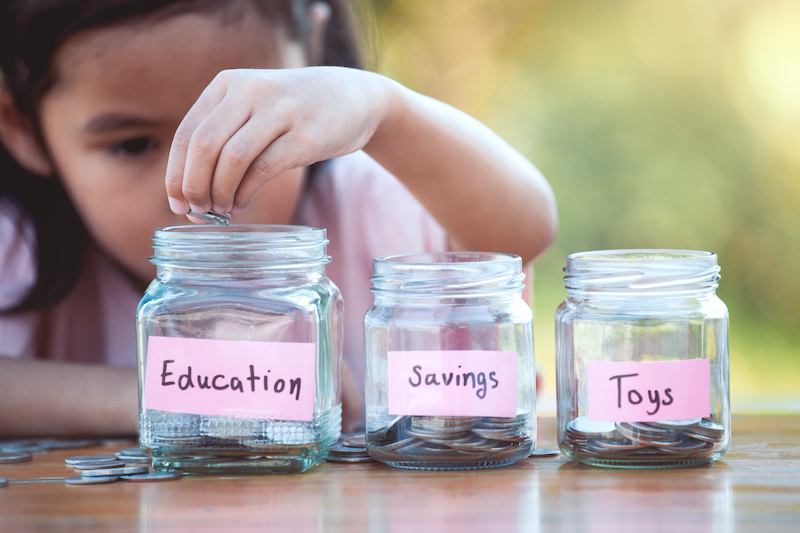

Last Updated on January 11, 2022 by Thinkster
Do you remember when you first learned the value of a dollar?
Maybe you had to sell a certain number of candy bars to help your local school buy more equipment and supplies. Or maybe you set up a lemonade stand in the blistering heat of the Summer, sweating buckets just so you could earn a little extra coin for your piggy bank.
Or, perhaps you grew up in a situation where financial discussions were common practice in your home.
Your mom and dad openly talked about where your family stood: how much money was coming in, how much was going out, and how much you’d all need to maintain or achieve a particular lifestyle.
All these experiences have an impact—and they all shape our relationship with money. And, chances are, your kids have already started to form their own perspective on financial literacy.
Teaching kids about money is a critical step in the development process, though. One that sets the stage for long-term success.
“Without a working knowledge of money, it is extraordinarily difficult to do well in life,” says Sam X Renick, co-creator of Sammy Rabbit, a children’s character and financial literacy initiative. “Money is central to transacting life, day-in and day-out. Where we live, what we eat, the clothes we wear, the car we drive, healthcare, education, child-rearing, gift giving, vacations, entertainment, heat, air-conditioning, insurance—you name it, money is involved.”
Research backs this up, too.
A 2018 National Financial Capability Study found that a strong financial education translates to healthy financial behavior like saving more, spending less, and being less likely to overdraw a checking account.
Yet, many parents aren’t helping their kids fully understand what it means to earn, save, and spend. A survey conducted by BECU in 2019 found that a large percentage of parents simply aren’t having the conversation to teach kids about money at all.
While all respondents said they’d much rather discuss finances with their kids over other difficult topics, like sex or substance abuse, only 28% are actually following through.
The real kicker here is that 82% of these parents say that fear is what’s holding them back.
And now for some hard truth: If you’re not teaching your kids about money, regardless of your reasoning, someone else will. Kids are hungry for information and left to their own devices, they will inevitably form thoughts and opinions around finances—and these values might not align with your own.
Suppose you want to play a more significant role in helping your kids develop a healthy relationship with money. In that case, you need to teach them all about fiscal responsibility and financial literacy.
And you need to start now.

The world moves fast. And as it evolves, so do our discussions around money.
New products emerge, new services hit the market, and new philosophies take root in our collective consciousness.
Cold, hard cash—for example—is no longer the primary currency of the realm.
Instead, as technology has advanced, paper and coin have mostly been brushed aside as credit cards, debit cards, and electronic transfers have become consumers’ preferred methods for payment.
Even cryptocurrency and bitcoin are on the rise.
To illustrate this point, a 2019 survey from the Federal Reserve Bank of San Francisco showed that consumers preferred cash payments in only 26% of transactions—a steep decline from previous years.
Complicating matters even further, we’ve got Venmo, Paypal, Affirm, Coinbase, and a seemingly endless list of other products all claiming to be the “future” of the industry.
Then, just to throw fuel on this crowded little fire, we have mortgages, student loans, insurance policies, and investment/retirement accounts—all of which we’re expected to understand to a profound degree.
But first, it’s important to understand what we mean when we talk about financial literacy—a popular term that refers to a variety of important financial skills and concepts:
A strong foundation here can help your kids achieve a great deal while avoiding the pitfalls that come with the mismanagement of funds and accounts.
And what does this foundation look like?
Solid budgets help control your spending, and ensure that you always have enough cash set aside for the things you really need. Young kids who feel empowered to track their finances, even if it’s just a few dollars a week, will grow to understand the definition of cost and gain a new level of respect for what it takes to earn.
Saving when you’re young is one of the best ways to prepare for the future—it’s a wonderful habit, and many adults still struggle to master the practice. Of course, we don’t expect your kids to balance a checkbook or spend their spare time banking. All kids should have a piggy bank, though. Because saving teaches what it means to live within your means.

When committed to paper, short- and long-term goals help shape new behaviors. They’re incredibly motivating and help us take stock of what we need to make the most out of life. This goes for virtually every aspect of life, too: academic achievements, career success, physical health, and—of course—financial security. Studies have shown that people who set goals experience greater financial success and feel better about their financial situation than those who do not.
Those who know how to avoid racking up thousands of dollars in credit card debt probably had some insightful discussions regarding fiscal responsibility as they were growing up. While some level of debt is virtually unavoidable, there is such a thing as too much, and people who know how to avoid high-interest rates and recognize signs of compulsive spending have healthier debt to income margins.
There’s no denying the importance of finance in today’s world. While money doesn’t necessarily buy happiness, it certainly gives us the freedom to pursue the life we want.
Unfortunately, 4 in 7 Americans are financially illiterate. And only 34% of Americans can correctly answer at least 3 of 5 basic financial literacy questions.
This general lack of financial knowledge can lead to poor credit, bankruptcy, housing foreclosure, and other negative consequences.
By the time your kids hit their 20s, they’ll get just a small taste of how heavy some financial burdens can be. They may not be skilled enough yet to get what they all call a “real” job, but they’ll certainly have bills of their own: car payments, rent, and credit card payments—not to mention the possibility of student debt.
If they haven’t learned what it takes to manage all this, they could find themselves in a position where filing for bankruptcy seems like their only option. But filing too young can have a devastating impact on credit scores, the ability to rent or buy a home, and maybe even future employment opportunities.
FICO Score 8—the most widely used version of the FICO scoring model—ranges from 300 to 850. Scores between 580 and 669 are considered fair while scores less than 580 are considered poor or bad.
Because borrowers with poor credit scores are higher risks for lenders, bad credit can make life difficult in a number of ways:
One of the biggest mistakes anyone can make—financially speaking—is defaulting on their loans. The consequences here are severe and, for all intents and purposes, should be avoided at all costs. (forgive the pun.)
Failure to make payments on time can lead to wage garnishments, lawsuits, and debt acceleration. It can also drag credit scores into the mud and result in extremely high interest rates on any future loans. The bank may even seize assets in extreme cases, leaving borrowers scrambling to find shelter and transportation.
Most everyone worries about money. In fact, it’s so common that if you’ve never worried about your cash flow, you’re…well, weird. And fortunate.
In other words, some level of stress is completely normal. Healthy, even.
But financial anxiety is different.
It’s an obsessive fear of all things related to money—and folks who suffer from this particular brand of anxiety get so caught up in the cycle of worry that they tend to avoid all their financial obligations. Bills pile up, debts go unpaid, notices remain unopened.
They probably don’t even look at their bank account.
Like other forms of anxiety, financial anxiety is unhealthy and can have a dramatic impact on your physical health:

Healthy financial habits can be difficult to form. But you’re not doing your kids any favors by putting all this on the backburner.
If you really want your children to avoid all the financial-related stresses we reviewed above, you need to start having these conversations right now—today, even.
But maybe you’re already ahead of the game. Perhaps you’ve already started talking to your kids about financial responsibility.
The question, then, is whether you’re teaching your children about money in a way that resonates.
Because the right lesson taught the wrong way rarely sticks.
So, in the spirit of financial freedom, let’s break down a few approaches you can take to ensure your kids develop healthy habits that lead to long-term financial success.
A healthy relationship with money starts with a simple conversation.
We know society has unnecessarily turned the discussion of financial literacy into a sort of taboo. And we understand this isn’t easy.
But the only way to drive change and help your children learn is to embrace the awkwardness and have regular family discussions about money.
And when we say “family” discussions, we mean that everyone should be involved. While you might want to protect your littles and shield them from the stress that money woes can cause, these talks don’t have to be overly emotional or tense. They can be fun, too.
Worried about how this might go? Here are a few pointers:
If you’re still not sure how to approach this, the Consumer Financial Protection Bureau has a fantastic resource that will help you have open, enjoyable, and valuable discussions with your children about money.
This might sound weird, but kids actually love responsibility. It makes them feel valued and appreciated. And in the same way they crave responsibility, they also crave independence.
That’s why kids need to have money of their own.
It helps them learn the true value of a dollar and empowers them to make their own decisions about when and how they spend their hard-earned cash.
But how do you help them earn their own money? They’re certainly not old enough for a part-time job.
The answer here is simple: Give them an allowance.
Most experts recommend starting your child with an allowance when they’re 5 or 6 years old. That’s when the concept of money usually starts to register in their brains. How you approach this idea is entirely up to you, but an easy way to set their allowance is to give your child one dollar per week for each year of their age.
For example, a 5-year-old entrepreneur would receive five dollars per week.
We also highly recommend that you require your children to contribute in some way to earn their money:

Saying one thing while doing another isn’t the best way to teach your kids smart financial behavior. If you truly want your children to develop good spending and saving habits, they need to see that you—their guardian, protector, and hero—always back up your words with definitive action.
That means you should model specific behaviors around money that you want your children to adopt:
In short, practice what you preach.
Every healthy habit your kids develop at a young age will inevitably make their adult lives easier and more rewarding.
And that’s not some hyperbolic overstatement.
It’s true.
These are formative years—and studies show that most habits are formed by age 9—so don’t hold off on teaching financial responsibility. Because letting them experiment and fail now will only help as your children get older and the stakes get higher.


